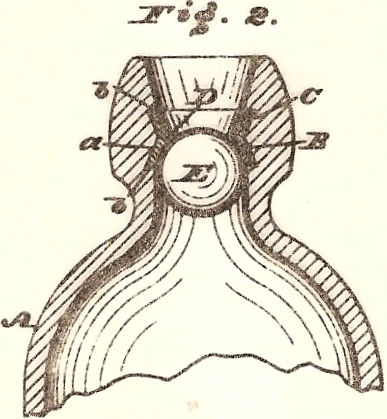William L. Roorbach Bottle Stopper


William L. Roorbach’s patent
application was filed March 27, 1885 and specified:
I, William L. Roorbach…of
Figure 1 represents a vertical section of a bottle and
stopper embodying my invention.
Fig. 2 represents a vertical section of a modification thereto…
My invention consists in an improvement in the class
of internal bottle-stoppers in which a bottle is provided with a grooved
neck to receive rubber packing, of the form of an annulus, whose outer
circumference conforms to the shape of the groove, and whose inner
circumference has an inclined face forming a “rise,” on which the
stopper has a seat, the top and bottom of said inner circumference being
flush with the neck of the bottle…
Primarily, the stopper is inserted in the neck of the
bottle, and the packing is them compressed in the groove
B, so that it closes part of
the space of the neck, preventing the escape of the stopper.
The bottle is filled and charged in any suitable manner, and the
pressure within the same holds the stopper on its seat.
In my former patent the packing is of cylindrical
form, and when compressed in the groove it assumes the double conical or
inclined form of the groove; but the upper and lower portions of the
packing are liable to loosen as they are compressed to less extent than
the middle portion, and thus the packing imperfectly holds the stopper.
In the present case the packing bears uniformly
against the side wall of the groove, and its upper and lower edges,
being covered by the top and bottom walls of the groove, are not liable
to slip out of the groove and the packing remains reliable in position.
It will also be seen that the stopper makes a joint on the rise
of the inner circumference of the packing, thus keeping the contents of
the bottle from coming in contact with the rubber, and exerts a pressure
diagonally upwardly and laterally outwardly on the packing, so that the
latter is more tightly pressed against the upper inner corner of the
groove, and its retention in the groove is assured.
Comments:
This is the second of three inter-related patents
filed by William L. Roorbach.
In addition to this
 HutchBook.com
HutchBook.com